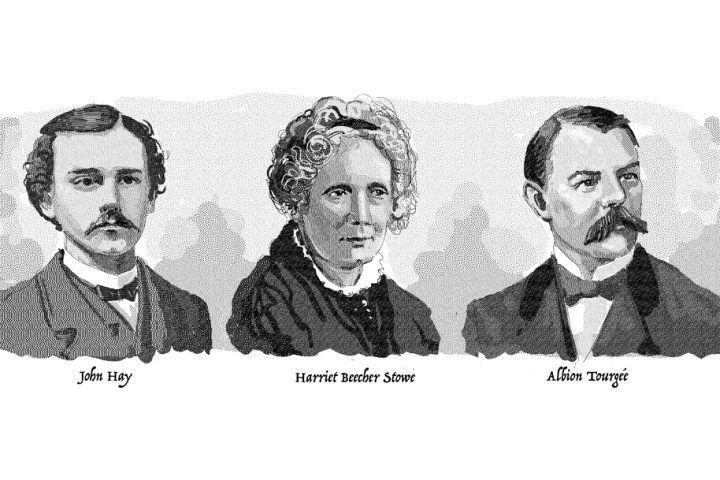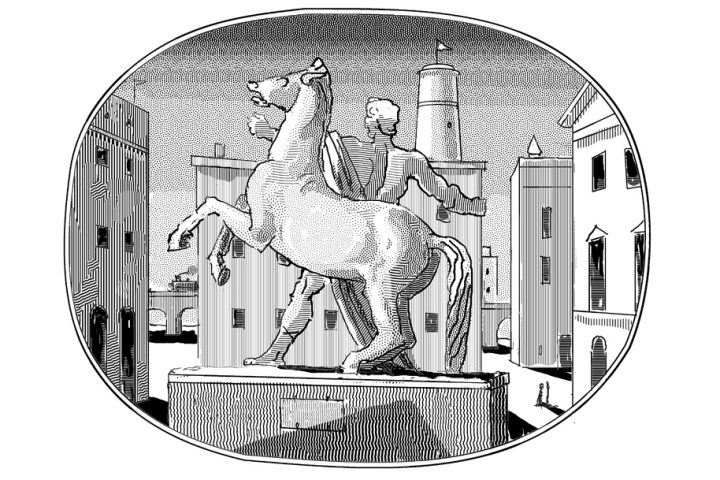Translating Goethe
 n his remarkably peevish review of The Essential Goethe (“Missing the Poetry,” Fall 2016), John M. Ellis makes the following remarks about my translation of Goethe’s Faust (Part One):
n his remarkably peevish review of The Essential Goethe (“Missing the Poetry,” Fall 2016), John M. Ellis makes the following remarks about my translation of Goethe’s Faust (Part One):
The translation is so concerned to chase a rhyme that it omits the image of the cottage, one so central to the play’s meaning: “And in a peaceful meadow by that stream / She [Gretchen] lived her simple life, her daily round / And all the childish thoughts that she could dream.” The violent forward motion of the torrent is lost too: it has become simply “that stream.” Throughout, the translator seems mostly interested in producing something that reads well and rhymes nicely, and to do that he’ll drop words and phrases in Goethe’s text at his whim, and add ones not there, too. This cavalier attitude toward the text soon leaves behind the play’s thought processes and the imagery that distils them.
I would like to take issue with one or two points here. Firstly, Ellis quotes only three out of four lines of the text: to crop a quotation in this way, thus distorting both syntax and sense, seems to me scarcely a fair or balanced way to review a text. The whole sentence reads: “And in a peaceful meadow by that stream / She lived her simple life, her daily round / And all the childish thoughts that she could dream / In that small world were safely hedged around”—which conveys a rather different sense. To accuse me of dropping phrases in Goethe’s text “at whim” strikes me as an egregious case of the pot calling the kettle black. Furthermore, Ellis objects that I have neglected the central Goethean motif of the “Hütte” or “cottage.” Now, any Goethe scholar worth his or her salt is familiar with Leonard Willoughby’s 1951 study of the image of the “Wanderer” and the “Hut” in Goethe’s poetry; although I have not literally cited the “hut” or “cottage,” it seems to me that most of the associations with which Goethe freights the image are included here: “peaceful meadow,” “simple life,” “daily round,” “small world,” “safely hedged around.”
Secondly, Ellis suggests that I am so concerned to chase a rhyme that my use of the word “stream” loses “the violent forward motion of the torrent.” But again, he refers selectively; immediately before his cropped quotation, my text reads (lines 3348-51): “I am accursed, a homeless refugee, / An aimless outcast driven relentlessly / Like a cascading torrent over rock and precipice, / Raging and seething into the abyss.” And immediately afterwards (lines 3356-61): “And I, whom God has cursed, / Was not content to thunder / In a foaming rage and burst / The tumbling rocks asunder. / I had to undermine that girl’s tranquillity— / That was the sacrifice that hell required of me.” Just how much violent forward motion does your reviewer want?
Of course this translator is interested in “producing something that reads well and rhymes” (though not necessarily “nicely”); this seems a not unworthy aim. Three distinguished Faust translators of the past 40 years or so—Walter Arndt, David Luke and David Constantine—have eloquently and persuasively argued the case for rhyme (or in Constantine’s case, for half-rhyme). For myself, I would certainly agree with David Luke that in translating Faust, “readable prosodic correspondence must be allowed priority over referential literalness.”
John R. Williams
University of St. Andrews
Scotland
John M. Ellis replies:
John Williams only undermines his own case. If he did indeed already know the seminal article by Leonard Ashley Willoughby that first explained how crucial the image of the cottage is, it becomes harder still to understand how Williams could have omitted it, for it represents nothing less than the polar opposite of the Faustian principle. In Mephisto’s words: “Fate has endowed him [Faust] with a spirit that always drives onward without restraint” (“ungebändigt immer vorwärts dringt”). The cottage embodies the opposing idea of perfect contentment through self-limitation. Its repetition throughout Faust links different kinds of contexts and, in so doing, develops the play’s argument by continually shedding new light on its basic ideas. To omit one of the most crucial examples of this central image should have been simply unthinkable. It is about much, much more than Gretchen’s peaceful meadow and simple life.
As to Williams’s citation of lines that describe the onrush of the torrent: they only serve to show how inconsistent his “stream” is with the rest of the play’s text. His mistranslation allows the destructive force that menaces Gretchen to become momentarily a part of her peaceful and static scene, which gets it onto the wrong side of the divide between two basic sets of images in Faust.
Government and the Private Sector
Irwin Stelzer has written a thoughtful review of our book, American Amnesia: How the War on Government Led Us to Forget What Made America Prosper (“Horse and Rabbit Stew,” Winter 2016/17). We are grateful that he believes the “ultimate testimonial to the value of this book is its ability to engage conservatives such as this reviewer,” and we can hardly argue with his fair-minded conclusion: “Jacob Hacker and Paul Pierson have made a far better case than has so far been made for the virtues of our mixed economy, and reminded critics of its phenomenal achievements.”
Nonetheless, we feel compelled to lodge two dissents. First, Stelzer appears to disagree with our argument that “collective assessments of leading knowledge institutions are not just one side in a controversy.” In doing so, he invokes the familiar conservative trope of climate scientists as “rent-seekers” who are “queuing up for research grants.” We are not sure whether he accepts the consensus view of these scientists that global warming represents a serious threat to humanity—a threat rooted in the failure of markets to take into account even huge costs (and benefits) that are borne by people not party to the relevant market transactions, a.k.a., externalities. But we hope that conservatives like Stelzer will not throw the baby of expertise out with the bathwater of (sometimes appropriate) skepticism of government. People can disagree with regard to particular trade-offs and ultimate values and yet still agree that when facts are at play—tobacco causes cancer, lead poisoning reduces kids’ I.Q., CO2 emissions are dangerously warming our planet—well-grounded scientific expertise should have greater weight than claims rooted in self-interest or ideology alone.
Second, Stelzer complains that we advocate for a balance between the state and the market that resembles the facetious recipe for “horse and rabbit stew,” nicely balanced between one horse and one rabbit. We are assuming he thinks government is the horse and the private sector the rabbit. But that would not be our favored concoction (or metaphor), nor an accurate description of the role played by government during America’s economic ascent or the role we think it should play in the future. In a mixed economy such as the United States, markets have an enormous and indispensable place—one that has been, is currently, and should be, larger than Stelzer’s mammal mishmash would suggest. The ten largest publicly-traded corporations in the world, after all, are headquartered in the United States. To quote Monty Python and the Holy Grail—and who could pass up the chance to recall the fearsome hare that dispatched so many of King Arthur’s men?—“That’s no ordinary rabbit!”
We prefer Charles Lindblom’s metaphor: the mixed economy is like a hand. There are the nimble fingers of the market and the strong thumb of government. You need those nimble fingers to respond flexibly to a changing world. But you also need that strong thumb to provide counter-pressure and traction, so you can grasp the opportunities that markets won’t seize on their own. The role of the thumb isn’t to direct the fingers; it is to push back against the well-known shortcomings of unregulated markets, such as externalities, as well as the tendency of market actors to try to capture government. The result is less a stable mix than a shifting relationship of creative tension. And, as we show in the book, it is this evolving combination of effective government and dynamic markets that propelled American prosperity in the last century—and could do so again in the 21st.
Jacob S. Hacker
Yale University
New Haven, CT
Paul Pierson
University of California, Berkeley
Berkeley, CA
Irwin Stelzer replies:
I welcome Messrs. Hacker and Pierson’s clarification of their position, reasonably stated, as to be expected from these authors. They are curious to learn whether I “accept…the consensus view of these scientists that global warming represents a serious threat to humanity.” Leave aside the question of just how much of a consensus there is—the cartel of believers having captured the professional and popular media, and gone to considerable length to prevent access by what they choose to call “deniers,” an offensive appropriation of a term until now reserved for those who deny the existence of the Holocaust. More important, from my point of view, is that there is a place for neither believers nor deniers in this debate. I am a skeptic. I have suspicion of models of the sort on which believers rely, especially when reality seems so often to fail to replicate their predictions, but am sufficiently uncertain to want to treat the risk as real enough for conservatives to “buy insurance” in the form of a carbon tax, which I have long advocated.
There are reasons other than climate change for doing just that, but the possibility that human activity is causing warming should not be dismissed, and a tax is surely a more efficient way to confront the problem than the costly regulations relied on until now. Perhaps conservatives deserve to be mired in that morass for rejecting President Obama’s cap-and-trade proposal, second in efficiency to a carbon tax. But, equally, environmentalists might deserve the current rollback of regulations as payment for their insensitivity to the costs of those rules.
As for viewing the private sector as nimble fingers and the government as the strong thumb—well, so long as that is not applied to the scales in a butcher shop, I suppose it is an acceptable analogy. I agree that it is the private sector—constrained at times by sensible regulation to cope with market failure—that is the most certain engine of future economic growth. I hope the authors agree that during the past eight years we have gone more than a little overboard in concocting rules, the costs of which exceed any imaginable benefits, and that liberating their nimble fingers from an over-heavy thumb might make for good policy.


